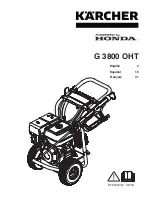
19
TROUBLESHOOTING
First try the solutions suggeste
d
here or visit our we
b
site an
d
reference FAQs (Frequently Aske
d
Questions) to possi
b
ly
avoi
d
the cost of a service call...
www.inglis.ca
Error co
d
es
If your Wash Status LED light is flashing:
This indicates that there is an issue with your washer.
To
d
etermine your error co
d
e:
First, notice the sequence of the flashes. The wash status light will
flash on for .5 seconds, then off for .5 seconds, followed by a
pause of 2 seconds and repeat. Count the number of flashes
before the pause to determine your first error code (F code). You
will then see a pause of 2 seconds, then start counting again to
determine your second code (E code).
Once you have gone through the sequence, you can determine
your Error Code.
Example:
If you have 8 flashes (0.5 sec On, 0.5 sec Off) - pause (2 sec) -
1 flash (0.5 sec On) this represents an “F8E1” error code.
If you are still experiencing problems, please call the numbers at
the front of the book, or call for service.
Check the list below for potential problem and troubleshooting
checks.
■
“F8E1” on
d
isplay (Long Fill - no water or insufficient
water supply)
Press POWER to cancel the cycle. Unplug washer or
disconnect power.
Electrical
S
hock Hazard
Plu
g
into a
g
rounded
3
pron
g
outlet.
Do not remove
g
round pron
g
.
Do not use an adapter.
Do not use an extension cord.
Failure to follow these instructions can result in death,
fire, or electrical shock.
WARNING
Plug in washer or reconnect power. Re-select cycle and press
START/PAUSE. If the problem remains, call for service.
■
“F9E1” on
d
isplay (Drain Pro
b
lem)
Press POWER to cancel the cycle. Unplug washer or
disconnect power.
Plug in washer or reconnect power. Re-select cycle and press
START/PAUSE. If the problem remains, call for service.
■
“F--E--” Varia
b
les (Washer Pro
b
lem)
Press POWER to cancel the cycle. Select DRAIN & SPIN if
there is excessive water in the washer.
Re-select cycle and press START/PAUSE. If the problem
remains, call for service.
Noisy, vi
b
rating, off-
b
alance
■
Is the washer level?
The washer must be level. The four feet should be properly
installed, and the nuts should be tightened against the washer
cabinet.
All four feet of the washer must be in firm contact with the
floor. If the washer is on a pedestal, the washer must be
secured to the pedestal and all four pedestal feet must be
in firm contact with the floor.
■
Di
d
you empty pockets?
You may be hearing items that are caught under the door seal
or basket. Check under the door seal and remove items.
■
Washer making a
d
ifferent noise?
As with any new product, you will hear sounds that you are
not accustomed to. You may hear various sounds when the
door is locked or unlocked, and during the washing, rinsing, or
spinning process. Between changes in wash actions, there
will be momentary pauses. You will hear water spraying and
splashing during the wash and rinse cycles. These new
sounds and pauses are part of normal washer operation.
■
Is washer installe
d
on a stur
d
y an
d
soli
d
floor?
Refer to the “Installation Instructions” for flooring
requirements. Noise and vibration may be reduced by placing
a piece of 3/4" (19 mm) plywood underneath your washer. The
plywood may extend underneath both washer and dryer to
keep them at equal heights.
■
Is the washer gurgling or humming?
As water is drained from the washer, you may hear air being
pulled through the pump. This happens during the end of
draining. It is normal.
■
Are you washing items with metal snaps,
b
uckles, or
zippers?
You may hear metal items touching the washer drum. This is
normal.
■
Were the 4 shipping
b
olts in the
b
ack of the machine
remove
d
?
See “Remove Transport System.”
Leaking
■
Was the
d
oor opene
d
d
uring “A
dd
Garment”?
Water can drip off the inside of the door, when the door is
opened after the start of a cycle.
■
Is HE
d
etergent
b
eing use
d
?
The non-High Efficiency detergents can cause oversudsing
which can leak from the rear of the washer.
■
Are the fill hoses tight?
■
Are the fill hose gaskets properly seate
d
?
Check both ends of each hose. See “Connect the Inlet
Hoses.”
■
Is the
d
rain hose properly installe
d
?
The drain hose should be secured to the drainpipe or laundry
tub. See “Secure the Drain Hose.”
■
Is the sink or
d
rain clogge
d
?
Sink and drainpipe must be able to carry away 17 gal. (64 L) of
water per minute. If the sink or drain is clogged or slow, water
can back up out of drainpipe or sink. Check household
plumbing (laundry tubs, faucets, drainpipe, water pipes) for
leaks.
















































